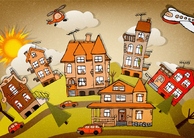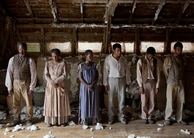Opinion:Child Murders in "Medea": Parallel, Past, and Present Use of Child Soldiers
By
2009, Vol. 1 No. 11 | pg. 1/1
KEYWORDS:
That wars are fought by the young for the old is a universally known truth. It is an ancient argument, a tired anti-war theme. Tired not in that it is hackneyed or obsolete, but in that its hollering admonitions have for all of time fallen on ears consistently deafened by bugles. The god of war does not discriminate among whose children his brutality destroys, though we ourselves usually tend to think of a “child soldier” as a twelve-year-old African boy hopped up on meth and indoctrinated in violence, or a teenaged Muslim boy strapping on a bomb and muttering prayers. After all, we allow into our military only “adults” 18 and older. But 18, like 16, 17, and 21, is a fictional benchmark that culture chose rather at random and assimilated into normalcy. In fact the human brain generally does not stop developing until age 25, so the majority of people fighting and dying in our infantry are, scientifically, children. How telling, that the words “infant” and “infantry” share the same origin; we literally cannot have an army without children. For me this is not the question. It is rather, what is the difference in our minds between the personal plot for revenge undertaken by Medea, and the large-scale processes of revenge undertaken by warring nations? Or, by what criteria does the blood on one’s hands test positive for murder? In our society moral strongholds that usually call upon us to protect and value our youth, as parents nurture and love their children, crumble under the stress of revenge and all the baggage it brings with it. When retribution the slumbering beast blinks awake, the havoc it soon kicks up leaves room for little else. Its vengeful roar easily drowns the music of life and love. So for a nation in the throes of passionate war-making, entranced by the perfume of hatred, the future—in the form of its young—is a fair price to pay for the defeat of its enemy, and Medea herself says so: “Laughter from my enemies is not to be endured, my friends. Come what may come!” (Morwood, 797-798). But this may be misleading, for Medea’s crime was not one of passion, and neither is any politician’s war—the build up to war is deliberate, marked by measured movements. It is not as though fury and glory combine to strike blind the facilitators of war, who send young people into harm’s way far from home. They are aware, as Medea was, of the “evil deeds” they perpetrate, but the threat to their power and the insult to their pride trumps their “counsel of softness” (Morwood, 1078-1080)—or, as most of them would more likely to say, their counsels of weakness.But one cannot properly create an attitude conducive to child sacrifice without, on some level, substantiating one’s actions to one’s own conscience. It is too convenient a simplification to imagine great leaders as caricatures beckoning, coaxing, and coercing youth from the arms of parents, passing their time in solitude twirling their mustaches and cackling in triumph with the hatching of diabolical schemes. Instead, as Medea demonstrates, the crucial element in the deed is, indeed, convincing the self. The perpetrators tell themselves that their acts are for the good of the children, as Medea hoped aloud her children would “find joy—but elsewhere” (Morwood, 1071-1073). This is, of course, an afterthought, a convenient excuse fallen from the sky—airmailed by the gods, maybe—masking ulterior motives. Not only the end attempting to justify the means, but the false end attempting to justify the disproportionate means. Better that they die than live in a world in which they and those they love are disgraced or oppressed: Medea proclaims, “it will never come to pass that I leave my children for my enemies to insult. There’s no alternative—they must die” (Morwood, 1059-1062). This perversion of love goes beyond deceit to denial, and through denial gives absolution from responsibility and from all its unpleasant stigmas—from guilt, from horror. One might say my entire argument falls apart with the observation that Medea’s acts are fundamentally different from those undertaken in war. After all, Medea murders only one set of children, children who are both hers and Jason’s, while nations in conflict offer up one set of children (their own) and bank on the destruction of another (their enemies’). And so logically I would have to decide whether I were arguing that nations murder their own youth or the enemy’s youth. But here is where my argument is, in fact, made: I assert that indeed both of these are true, that logic does not demand that I choose between them, that this is the most essential element in constructing the parallel between Medea’s murders and warfare. The only way Medea can destroy Jason is to destroy his children; the only way she can destroy his children is to destroy her own children. Likewise is it so in war. We cannot get what we want unless we give up what we have—in theory, a moot point. So Medea’s double homicide—the murder of two children, the murder of two parenthoods—illuminates the senselessness of war. That Medea and Jason have the same dead children extends the metaphor further because it questions the concept of “ours versus theirs” at its heart. This is another common anti-war tactic, explored in such works as All Quiet on the Western Front: through the humanization of the enemy, simplifying matters (not our people and their people, but just people) and thereby complicating them (it is no longer “okay” to kill them). When we throw our ticker tape victory parades, we also celebrate—whether we realize it or not, whether we like it or not—the rotting corpses of nineteen-year-old kids. We prefer not to think about it, but if forced to face it we would probably say that though the deaths of those children were undoubtedly unpleasant, “it had to be done” for the preservation of our collective life, our collective future. The horror of Medea’s crime comes not from the fact of her killing children (which would be heinous, indeed, but without unique stigmatic strength), but from the fact of her killing her own children. This simple truth is, in my opinion, acutely horrifying unto itself. If you were to ask an American or Briton in 1945, “Was the allied bombing of Dresden necessary?” the answer would probably be, “Yes.” And if you were to inquire further, “Why, then, was it necessary for thousands upon thousands of innocent children to die?” the answer would be probably be, “So that our own children would be protected.” Medea’s attitude reflects this exactly, as she mourns for “her children” but derives triumph from the death of “Jason’s children.” She perfectly demonstrates the absurdity of the phenomenon by which we seem to have an emotional capacity allowing for interest in only our own children, and yet again and again, we offer them up for sacrificial slaughter. The whole concept is bafflingly nonsensical, disgustingly twisted. A boy in the movie “In the Valley of Elah,” which makes an argument similar to mine supplemented by the biblical story of David and Goliath, asks at one point, “But why did they let David fight? He was just a boy.” Why? Why not? The young are both physically strong and naïve enough to be molded into patriotic killing machines. And the same thing for which we ourselves value them in peacetime—their promise—makes their destruction worthwhile to enemies in wartime. What would our enemies think, faced with battle-ready potbellies, receding hairlines, and broken dreams? How could we expect them to offer any of their valuable assets if we withheld all of ours? Medea speaks of “the bloody murder of my beloved children” (Morwood, 795-796) projecting onto her children the juxtaposition of such violence with such tenderness. By what criteria is one found guilty of infanticide? Whether we use our children as infantrymen or suicide bombers, we send them away with our blessing, our eyes fixed on an impeccably shined goblet of victory, spilling over with shiny red blood split from bodies barely formed now newly still. Suggested Reading from Inquiries Journal
Inquiries Journal provides undergraduate and graduate students around the world a platform for the wide dissemination of academic work over a range of core disciplines. Representing the work of students from hundreds of institutions around the globe, Inquiries Journal's large database of academic articles is completely free. Learn more | Blog | Submit Latest in Opinion |


















